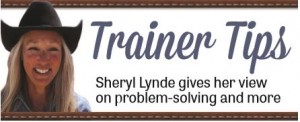 When people come for a lesson or an evaluation, there are common mistakes shared by most riders. Let’s talk about the Top Four and the remedy for each.
When people come for a lesson or an evaluation, there are common mistakes shared by most riders. Let’s talk about the Top Four and the remedy for each.
1. Lack of Rein Management
Reins being either too loose or too tight pose risks to a rider’s safety. When the reins are too loose, the rider’s hands are out of position, as they rise to their chest or chin in order to make contact with the bit. To make up for a lag in contact and response, the rider develops fast hands and jerks to get the response they are looking for.
Having the reins too tight causes the horse to brace against the rider’s hands. Since the horse learns from release and not pressure, there are limited training opportunities. The horse becomes micromanaged, meaning there is constant contact. Therefore, the horse is given no release for the correct response, and the rider balances on the horse’s mouth instead of their seat and is easily out of control.
Be aware of your rein length as you ride. When asking for a specific task, shorten your reins so that you feel contact when your hands are in front of the pommel. The small of your back should be soft and you should have a bend in your elbows. As soon as you get the correct response, release your reins by lengthening them again. If your horse immediately walks off or speeds up once you have released,, shorten your reins again and repeat as often as necessary for your horse to understand what you are teaching. You should be lengthening and shortening frequently throughout your ride. Relax your grip, slow your hands down and loosen your reins when your horse has given the appropriate response– your horse will appreciate it.
2. Leaning Forward
Riders usually lean forward to compensate for not using their seat and legs. By leaning forward, the rider’s toes point down and their seat lifts out of the saddle, causing the rider to become easily unbalanced if the horse were to make any sudden moves.
Your shoulders should be just slightly behind your hips as you sit with both sit bones making contact with the seat of your saddle. You can check your posture at any time by reaching behind you and touching the top of your horse’s rump with your hand as you walk, trot and cantor.
3. Holding your Breath
Holding your breath causes a brace in your body as well as your horse’s body. At any sign of trouble such as a spook or bolt, the rider gasps and holds their breath causing them to brace and lock up with their legs and body. This body language speaks volumes to your horse and clearly alerts them to your fear.
You need to do what is counter intuitive and RELAX. Breathe all the way into your legs and sit deep in the saddle. Slow your hands. The more frantic my horse gets, the calmer I get. I don’t want to raise my emotions to match his, I want him to lower his emotions and match mine. Someone in this duo has to set the tone.
4. Looking down
Riders have a tendency to either look down or at the back of their horse’s head. When you drive your vehicle, you wouldn’t stare at the hood of your car or at the broken white line when changing lanes. Looking down causes you to lean and lower your shoulder, making it more difficult for your horse to carry you. Look down, fall down. This is referred to as “target fixation.”
Just as when you are walking or driving, look where you are going and keep your chin up. When you do, there is a natural shift in your body that gives your horse a “pre-cue” as to the direction change. If I’m looking to the left, I will slightly open my left shoulder as well, which transfers my weight to my right seat bone signaling my horse for the change in direction. Slightly releasing my left leg and adding pressure with my right leg will reinforce the cue.
These are common mistakes that are shared by all, and the fix is awareness. Your horse’s behavior is a reflection of your communication to him through the use of your hands, seat and legs. Whenever you ride, you are either accepting behavior or giving clear boundaries that the horse can understand which translates to training. I know that I, too, am guilty in these areas at different times and I continue to be attentive to my cues. It takes vigilance and feel that can only come from hours in the saddle. Whether you ride trail, arena, or compete in a specific discipline, there will always be another level to strive to.
~Sheryl
Leave a Comment
All fields must be filled in to leave a message.